Buick Enclave: Specifications, Repair Instructions
SPECIFICATIONS
FASTENER TIGHTENING SPECIFICATIONS
Fastener Tightening Specifications
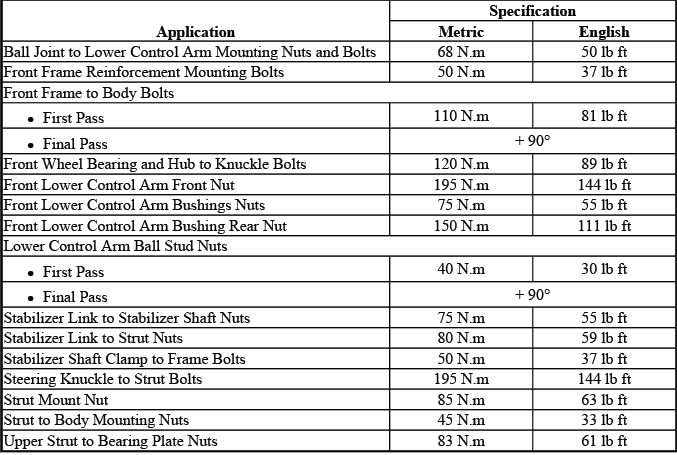
ADHESIVES, FLUIDS, LUBRICANTS AND SEALERS
Adhesives, Fluids, Lubricants and Sealers

REPAIR INSTRUCTIONS
STABILIZER SHAFT REPLACEMENT
Removal Procedure
1. Raise and support the vehicle. Refer to Lifting and Jacking the Vehicle.
2. Remove the front tire and wheel assemblies. Refer to Tire and Wheel Removal and Installation.
3. Remove the bolt from the intermediate shaft bracket to the front cradle. Refer to Front Wheel Drive Intermediate Shaft Replacement.
4. Remove the rear propeller shaft, if equipped. Refer to Propeller Shaft Replacement.
5. Disconnect the outer tie rods from the steering knuckles. Refer to Steering Linkage Outer Tie Rod Replacement.
6. Disconnect the stabilizer shaft links from the stabilizer shaft. Refer to Stabilizer Shaft Link Replacement.
7. Position an adjustable jack stand underneath the left rear and right rear of the front frame.
8. Remove the left and right frame reinforcement mounting bolts.
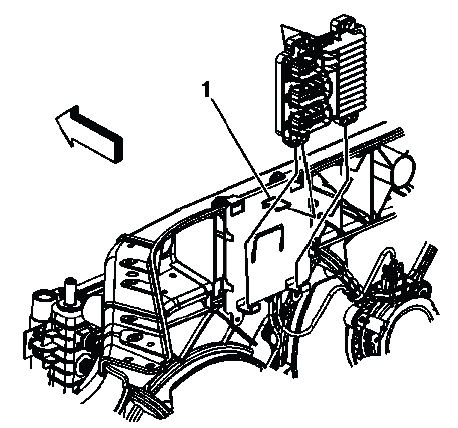
Fig. 1: Identifying Frame Reinforcement Mounting Bolts
9. Loosen the front frame reinforcement mounting bolts (1).
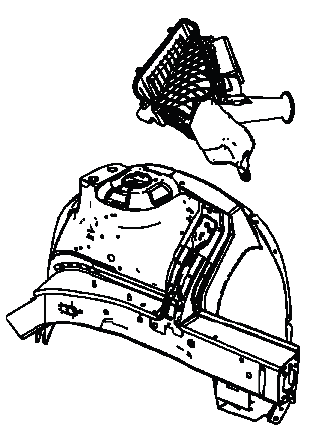
Fig. 2: Identifying Front Frame Mounting Bolts
10. Loosen the front frame mounting bolts (2).
11. Loosen the front frame rear mounting bolts (1).
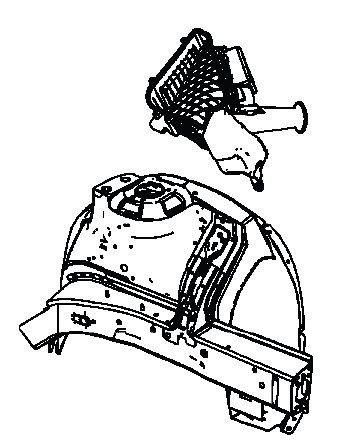
Fig. 3: Locating Rear Frame Mounting Bolts
12. Lower the front frame (1) from the frame rail (2) until enough clearance is gained to remove the stabilizer shaft.
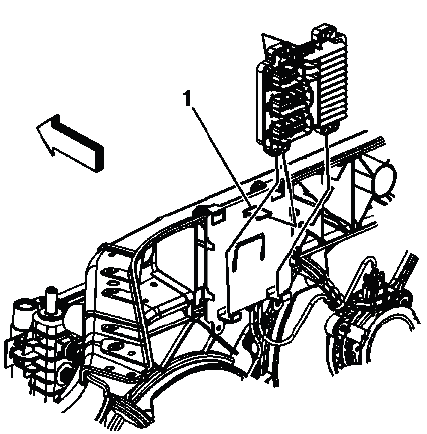
Fig. 4: Identifying Frame & Frame Rail
13. Remove both left and right stabilizer shaft insulators. Refer to Stabilizer Shaft Insulator Replacement.
NOTE: If replacing the stabilizer shaft, use NEW insulators.
14. Remove the stabilizer shaft from the vehicle.
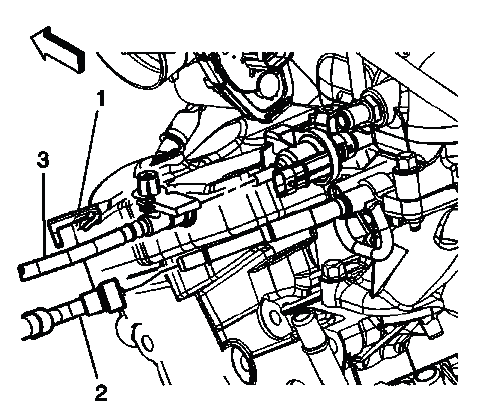
Fig. 5: Positioning Stabilizer Shaft
NOTE: It may be necessary to maneuver the stabilizer shaft in order to remove the stabilizer shaft from the front frame.
Installation Procedure
1. Position the stabilizer shaft on the front frame.
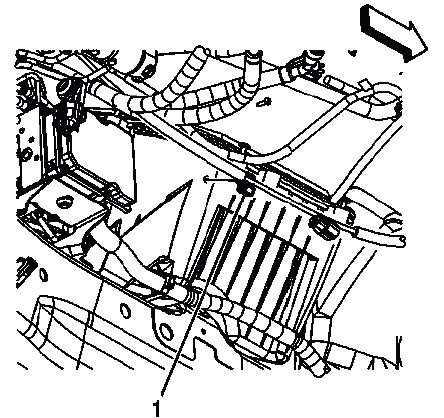
Fig. 6: Positioning Stabilizer Shaft
2. Install the left and right stabilizer shaft insulators and brackets. Refer to Stabilizer Shaft Insulator Replacement.
3. Connect the stabilizer shaft links to the stabilizer shaft. Refer to Stabilizer Shaft Link Replacement.
4. Using the jack stands, raise the front frame to the vehicle body leaving a gap of approximately 12 mm (0.5 in).
5. Install the front frame mounting bolts (2) and tighten to 110 N.m (81 lb ft).
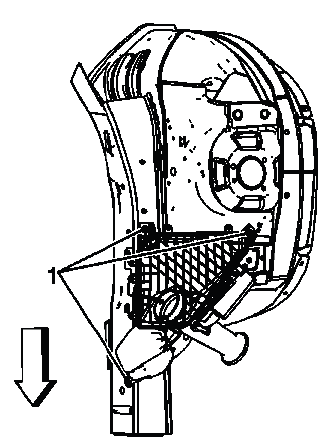
Fig. 7: Identifying Front Frame Mounting Bolts
CAUTION: Refer to Fastener Caution.
6. Tighten the front frame mounting bolts an additional 90º.
7. Tighten the front frame reinforcement mounting bolts (1) to 50 N.m (37 lb ft).
8. Install the front frame rear mounting bolts (1) and tighten to 110 N.m (81 lb ft).
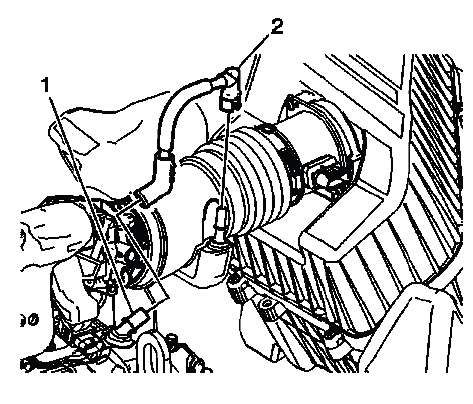
Fig. 8: Locating Rear Frame Mounting Bolts
9. Tighten the front frame rear mounting bolts an additional 90º.
10. Install the left and right front frame reinforcement mounting bolts and tighten to 50 N.m (37 lb ft).
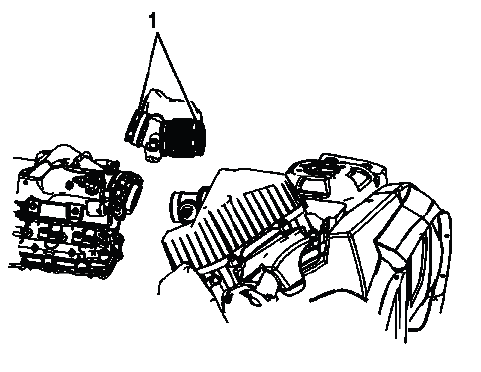
Fig. 9: Identifying Frame Reinforcement Mounting Bolts
11. Remove the adjustable jack stands.
12. Install the bolt from the intermediate shaft bracket to the front cradle. Refer to Front Wheel Drive Intermediate Shaft Replacement.
13. Connect the outer tie rods to the knuckle. Refer to Steering Linkage Outer Tie Rod Replacement.
14. Install the rear propeller shaft, if equipped. Refer to Propeller Shaft Replacement.
15. Install the front tire and wheel assemblies. Refer to Tire and Wheel Removal and Installation.
16. Remove the support and lower the vehicle.
STABILIZER SHAFT LINK REPLACEMENT
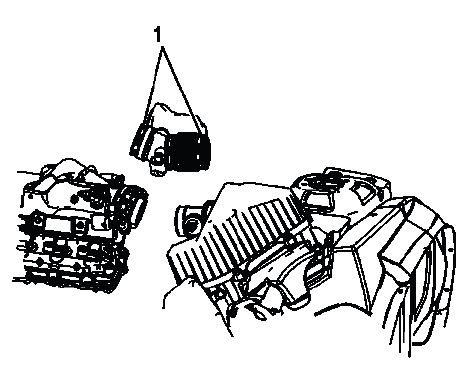
Fig. 10: Identifying Stabilizer Shaft Link
Stabilizer Shaft Link Replacement
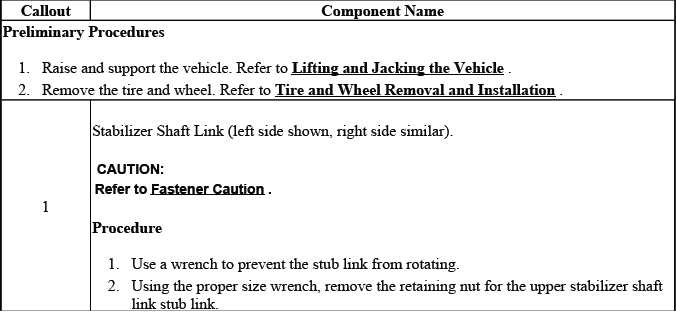

STABILIZER SHAFT INSULATOR REPLACEMENT
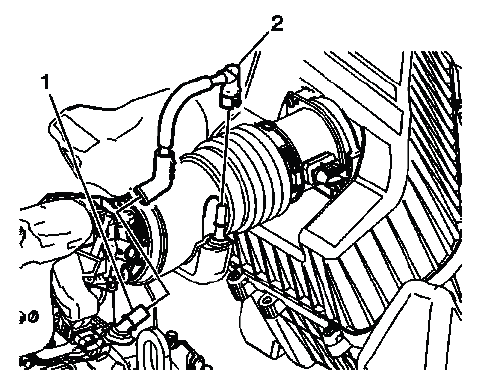
Fig. 11: Identifying Stabilizer Shaft Insulator
Stabilizer Shaft Insulator Replacement


LOWER CONTROL ARM BALL JOINT REPLACEMENT
Removal Procedure
1. Remove the lower control arm assembly. Refer to Lower Control Arm Replacement.
2. Install the lower control arm in a vise.
3. Drill or grind off the head of the rivet.
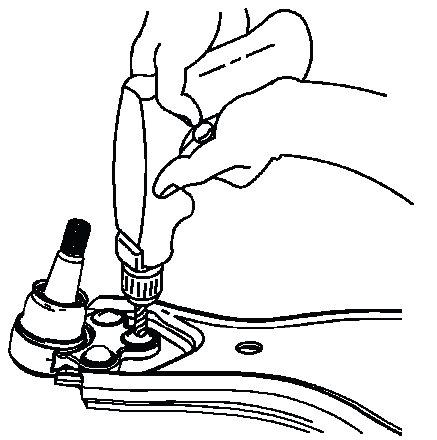
Fig. 12: Drilling Off Head Of Rivet
NOTE: Use a center punch to aid in starting the drill if drilling the rivet.
4. Use a punch and a hammer to loosen the rivets from the lower control arm.
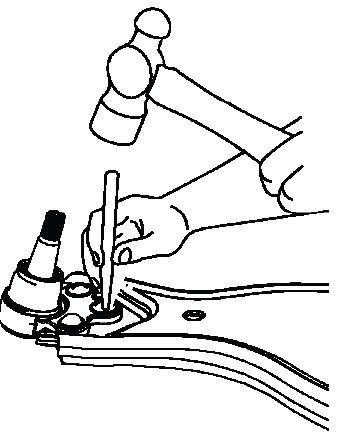
Fig. 13: Removing Rivets With A Punch And A Hammer
5. Remove the rivets from the lower control arm.
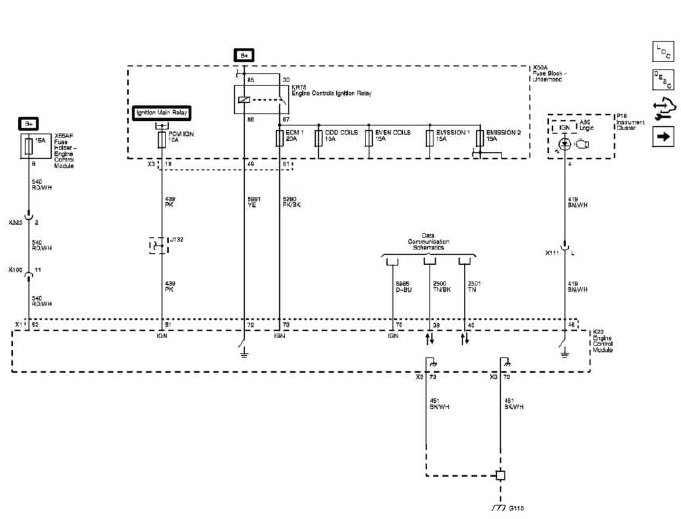
Fig. 14: Removing Rivets
6. Enlarge the hole for the ball joint bolt to 31/64.
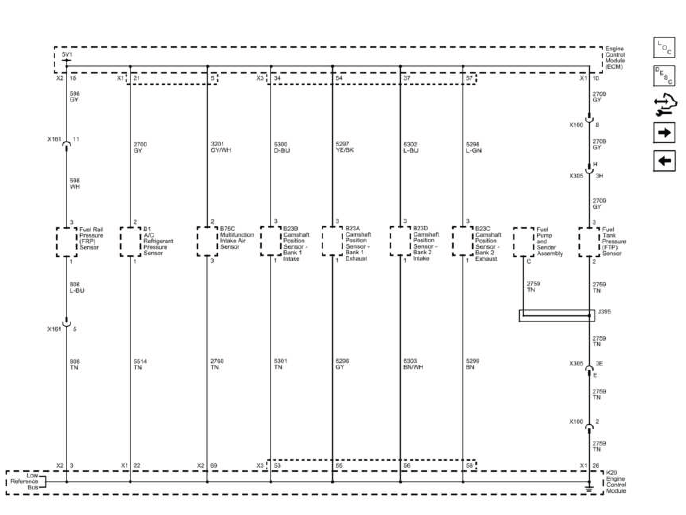
Fig. 15: Removing/Installing Ball Joint At Lower Control Arm
7. Remove the ball joint from the lower control arm.
Installation Procedure
1. Position the ball joint on the lower control arm.
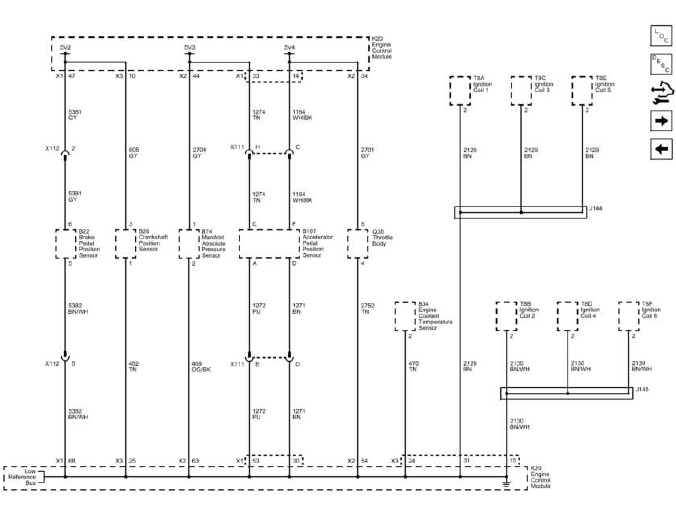
Fig. 16: Removing/Installing Ball Joint At Lower Control Arm
2. Install the ball joint mounting nuts and bolts.
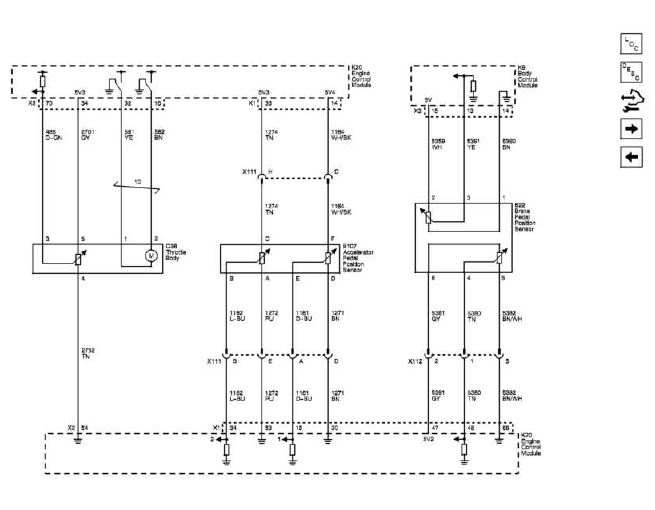
Fig. 17: View Of Ball Joint Mounting Nuts & Bolts
CAUTION: Refer to Fastener Caution.
NOTE: When tightening the mounting nuts and bolts for the ball joint, hold the bolt and torque the nut for the proper torque measure.
Tighten
- Tighten the mounting nuts to 68 N.m (50 lb ft).
3. Remove the lower control arm assembly from the vise.
4. Install the lower control arm. Refer to Lower Control Arm Replacement.
5. Check the front end alignment of the vehicle. Refer to Wheel Alignment Specifications.
FRONT WHEEL BEARING AND HUB REPLACEMENT
Special Tools
- J 42129 Wheel Hub Puller
CAUTION: The wheel bearing and hub assembly includes a magnetic encoder with built-in permanent magnets that the wheel speed sensor senses. Any contact with another magnet will damage the encoder magnets. The damage will cause a diagnostic trouble code to be set and will require wheel bearing and hub replacement.
Removal Procedure
1. Raise and support the vehicle. Refer to Lifting and Jacking the Vehicle.
2. Remove the tire and wheel. Refer to Tire and Wheel Removal and Installation.
3. Remove the front brake rotor. Refer to Front Brake Rotor Replacement.
4. Remove the wheel drive shaft retaining nut and washer. Refer to Front Wheel Drive Shaft Replacement.
5. Install the J 42129 Wheel Hub Puller to the wheel bearing and hub.
6. Using the J 42129 Wheel Hub Puller, separate the wheel drive shaft from the wheel bearing and hub.
7. Remove the J 42129 Wheel Hub Puller from the wheel bearing and hub assembly.
8. Remove the front wheel bearing hub bolts.
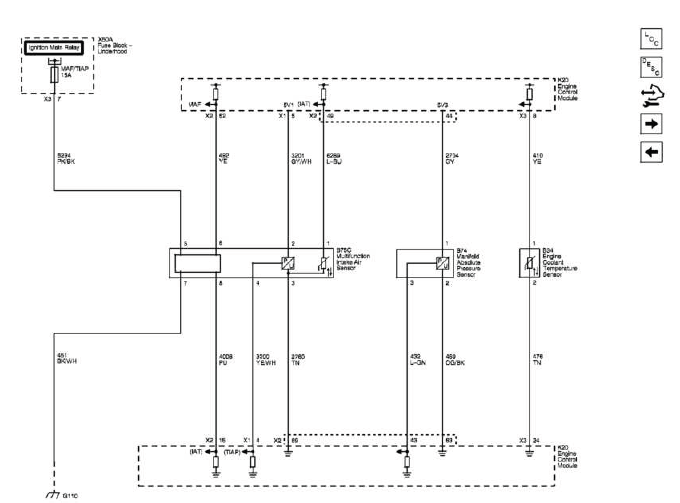
Fig. 18: View Of J 28733-B Installed Onto Wheel Hub
9. Remove the wheel bearing and hub assembly.
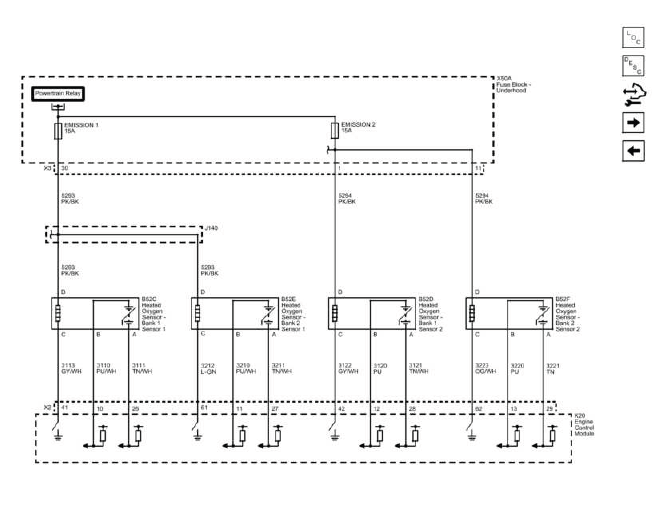
Fig. 19: Identifying Wheel Bearing & Hub Assembly
Installation Procedure
1. Position the wheel bearing and hub assembly in the knuckle.
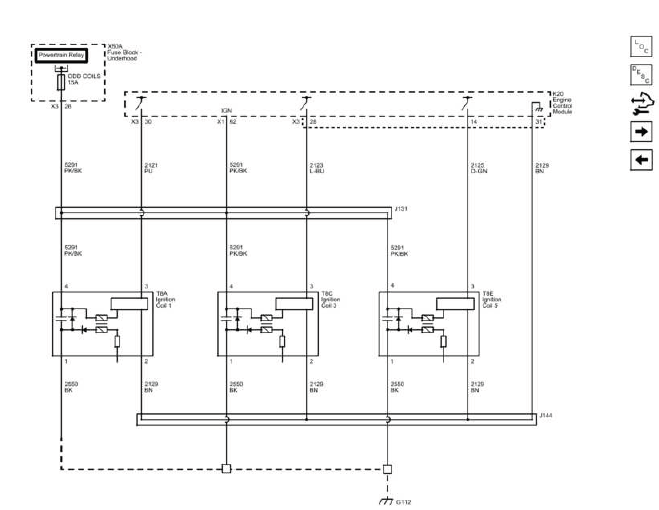
Fig. 20: Identifying Wheel Bearing & Hub Assembly
2. Using an approved solvent, clean the old threadlocker from the threads of the wheel bearing hub and the bolts.
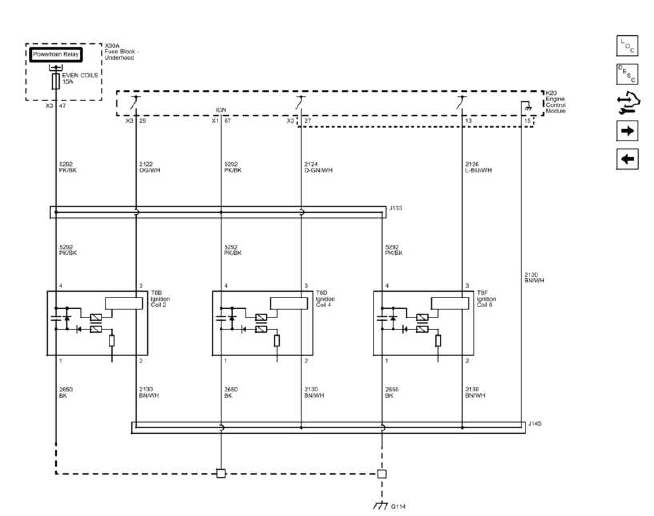
Fig. 21: View Of J 28733-B Installed Onto Wheel Hub
3. Apply the high-temperature, high-strength threarlocker to 2/3 of the threads of the wheel bearing and the bolts.
NOTE: Ensure that there are no gaps in the threadlocker and allow to dry approximately 10 minutes before installing the wheel bearing bolts.
4. Install the retaining bolts for the wheel bearing and hub.
CAUTION: Refer to Fastener Caution.
Tighten
- Tighten the bolts to 120 N.m (89 lb ft).
5. Install the front brake rotor. Refer to Front Brake Rotor Replacement.
6. Install the wheel drive shaft retaining nut and washer. Refer to Front Wheel Drive Shaft Replacement.
7. Install the tire and wheel. Refer to Tire and Wheel Removal and Installation.
8. Remove the support and lower the vehicle.
STEERING KNUCKLE REPLACEMENT
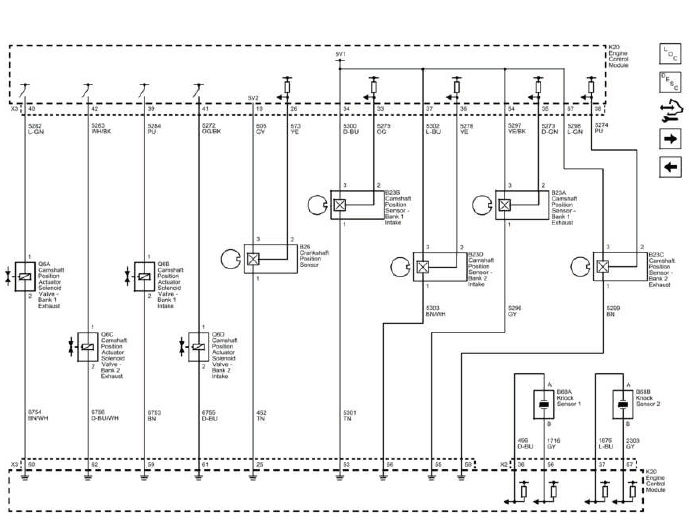
Fig. 22: Identifying Steering Knuckle
Steering Knuckle Replacement
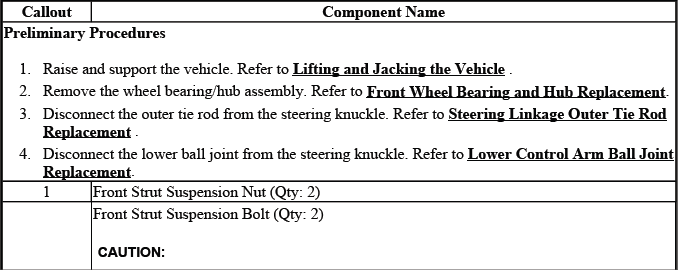

LOWER CONTROL ARM REPLACEMENT
Special Tools
- J 42188-B Ball Joint Separator
For regional equivalent tools, refer to Special Tools.
Removal Procedure
1. Raise and support the vehicle. Refer to Lifting and Jacking the Vehicle.
2. Remove the tire and wheel. Refer to Tire and Wheel Removal and Installation.
3. Disconnect the outer tie rod end from the steering knuckle. Refer to Steering Linkage Outer Tie Rod Replacement.
4. Turn the knuckle to the left.
5. Using the J-42188-A (2) and a wrench, loosen the lower ball joint nut.
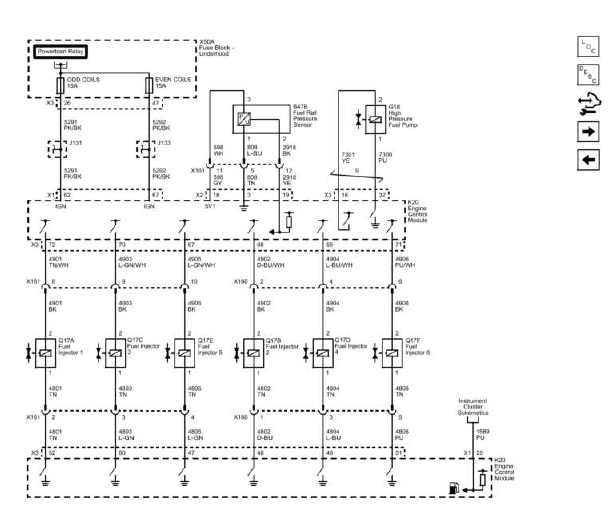
Fig. 23: Identifying J 42188 Ball Joint Separator
6. Using the J 42188-B separator (1), disconnect the lower ball joint from the knuckle.
7. Remove the lower ball joint nut (1).
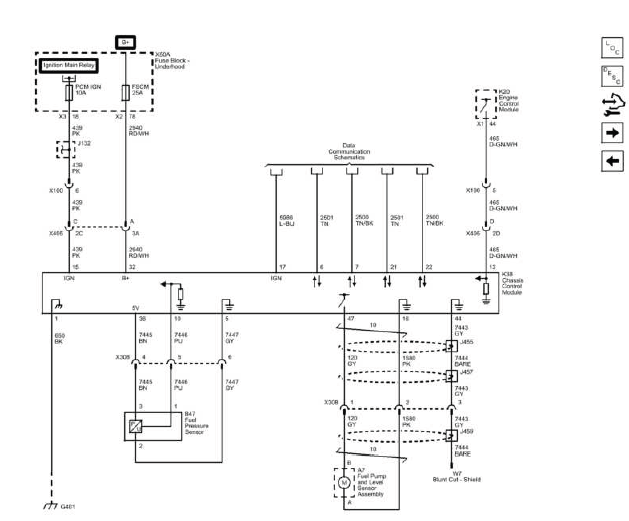
Fig. 24: Identifying Lower Ball Joint Retaining Nut
8. Remove the front lower control arm front nut (4) from the stud (3).
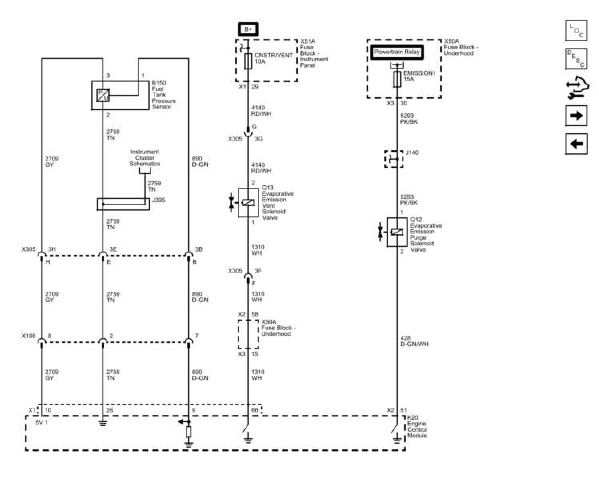
Fig. 25: Identifying Control Arm Mounting Bolt And Nut
9. Remove the lower control arm rear nut (2) and bolt (1).
10. Remove the front lower control arm (1) from the vehicle.
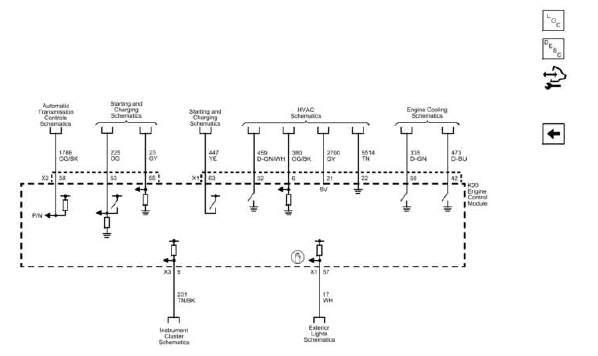
Fig. 26: Identifying Lower Control Arm
Installation Procedure
1. Position the front lower control arm (1) in the frame.
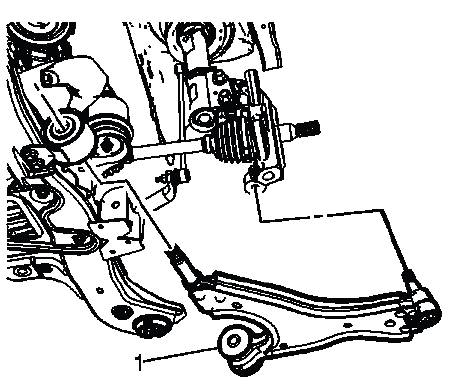
Fig. 27: Identifying Lower Control Arm
2. Install the front lower control arm rear nut (2) and bolt (1). Hand tighten the rear nut (2).
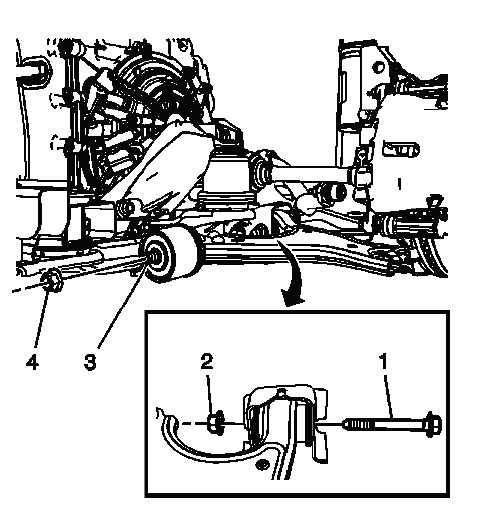
Fig. 28: Identifying Control Arm Mounting Bolt And Nut
3. Install the front lower control arm front nut (4) to the stud (3) and tighten to 195 N.m (144 lb ft).
CAUTION: Refer to Fastener Caution.
4. Tighten the front rear lower control arm rear nut (2) to 150 N.m (111 lb ft).
NOTE: Use the appropriate size wrench to hold the bolt while torquing the nut.
5. Connect the lower ball joint in the knuckle.
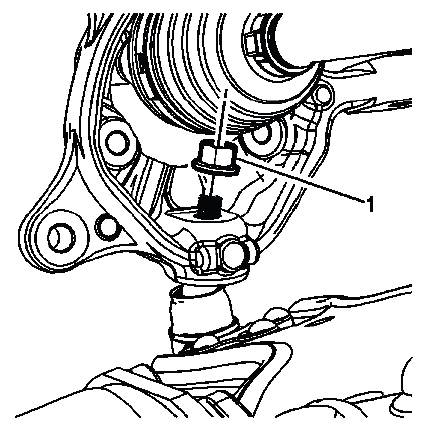
Fig. 29: Identifying Lower Ball Joint Retaining Nut
6. Install the ball joint nut and tighten to:
- First Pass: 40 N.m (30 lb ft)
- Final Pass: plus 90º.
7. Connect the outer tie rod end. Refer to Steering Linkage Outer Tie Rod Replacement.
8. Install the tire and wheel assembly. Refer to Tire and Wheel Removal and Installation.
9. Remove the support and lower the vehicle.
FRONT LOWER CONTROL ARM BUSHING REPLACEMENT
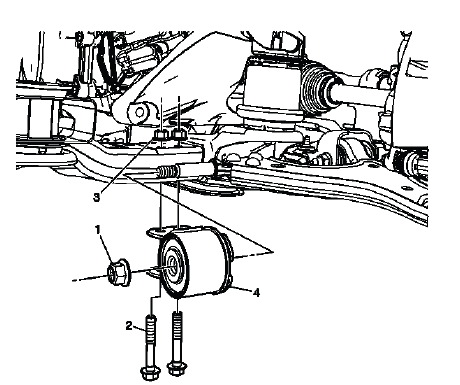
Fig. 30: Identifying Lower Control Arm Bushing & Bracket
Front Lower Control Arm Bushing Replacement
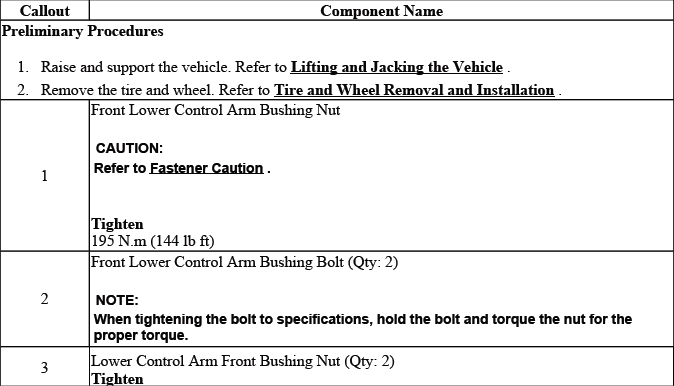

FRONT LOWER CONTROL ARM REAR BUSHING REPLACEMENT
Special Tools
- CH-48107 Bushing Remover and Installer
- J 2619-01 Slide Hammer and Adapter
- J 5590 Installer and Remover
Removal Procedure
1. Remove the front lower control arm assembly. Refer to Lower Control Arm Replacement.
2. Install the lower control arm in a soft jawed vise.
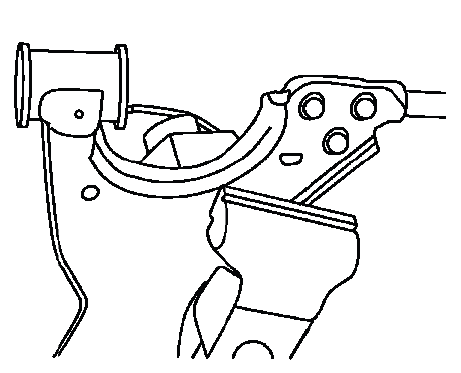
Fig. 31: View Of Lower Control Arm In Soft Jawed Vise
3. Assemble the J 2619-01 Slide Hammer and Adapter and the CH-48107 Bushing Remover and Installer.
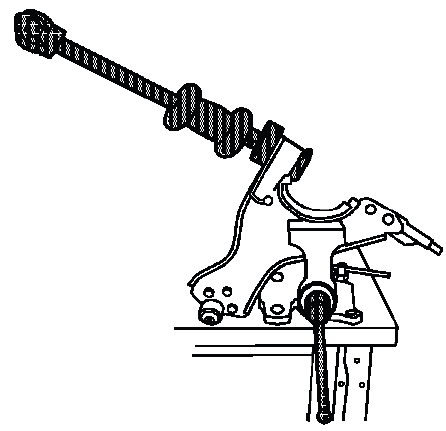
Fig. 32: Identifying Special Tools J 2619-01 & CH-48107
4. Position the J 2619-01 Slide Hammer and Adapter and the CH-48107 Bushing Remover and Installer lower control arm bushing.
5. Using the J 2619-01 Slide Hammer and Adapter and the CH-48107 Bushing Remover and Installer, remove the front lower control arm bushing.
6. Using the J 5590 Installer and Remover, remove the rear lower control arm bushing.
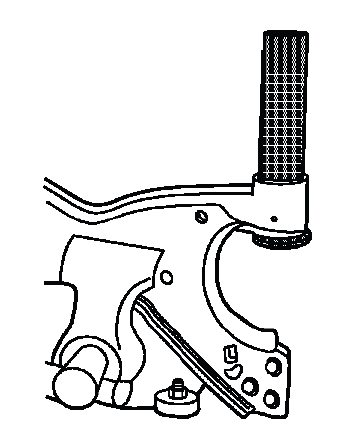
Fig. 33: Identifying Special Tool J 5590
Installation Procedure
1. Position the front and rear bushings so that they are equally in the control arm.
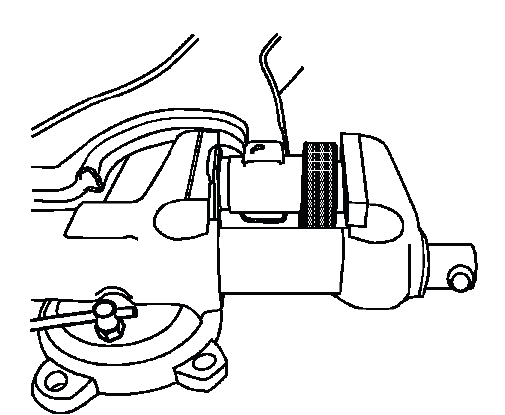
Fig. 34: Identifying Front & Rear Bushings
2. Position the CH-48107 Bushing Remover and Installer on the front bushing.
3. Using the vise, compress the front and rear bushings until they are seated.
4. Remove the lower control arm from the vise.
5. Remove the CH-48107 Bushing Remover and Installer from the front bushing.
6. Install the lower control arm in the vehicle. Refer to Lower Control Arm Replacement.
WHEEL STUD REPLACEMENT
Special Tools
- J 35917 Ball Joint Remover
Removal Procedure
WARNING: If you are replacing the wheel(s), the wheel stud(s), the wheel nut(s) or the wheel bolt(s), install only new GM original equipment parts. Installation of used parts or non-GM original equipment parts may cause the wheel to loosen, loss of tire air pressure, poor vehicle handling and loss of vehicle control resulting in personal injury.
1. Raise and support the vehicle. Refer to Lifting and Jacking the Vehicle.
2. Remove the tire and wheel. Refer to Tire and Wheel Removal and Installation.
3. Remove the brake rotor. Refer to Front Brake Rotor Replacement.
4. Use the J 35917 Ball Joint Remover in order to press the wheel stud (1) from the bearing/hub (2).
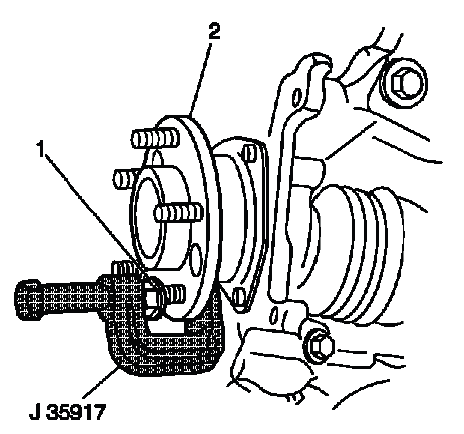
Fig. 35: Identifying J 35917 To Press Wheel Stud From Bearing/Hub
Installation Procedure
1. Install a new wheel stud from the back side of the bearing/hub.
2. Install 3 flat washers (1) to the wheel stud (3).
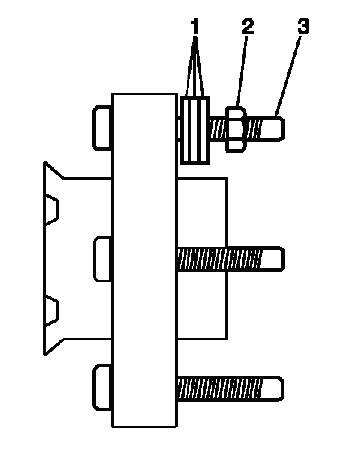
Fig. 36: Identifying Washers, Wheel Stud & Hex Nut
3. Install a hex nut (2) to the wheel stud (3).
4. Tighten the hex nut until the stud head is fully seated in the bearing/hub flange.
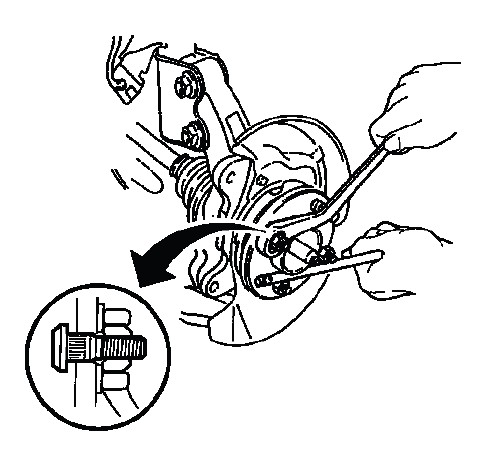
Fig. 37: Seating Stud Head Fully In Bearing/Hub Flange
5. Remove the hex nut and the washers from the wheel stud.
6. Install the brake rotor. Refer to Front Brake Rotor Replacement.
7. Install the tire and wheel. Refer to Tire and Wheel Removal and Installation.
8. Lower the vehicle.
STRUT AND SHOCK ABSORBER INSPECTION (STRUT)
NOTE: The strut assembly DOES NOT have to be removed from the vehicle to perform the following inspection procedure.
NOTE: A light film of oil on the top portion of the strut is normal. DO NOT replace the strut for this condition.
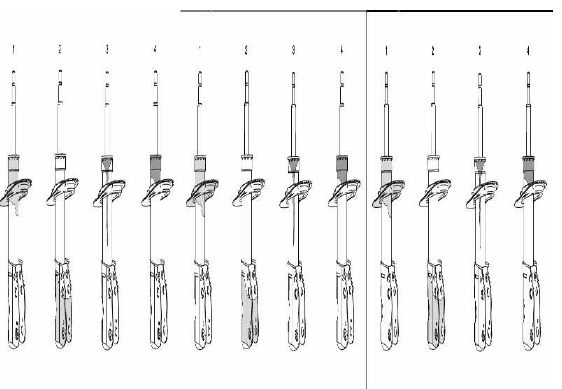
Fig. 38: Illustrating Of Strut Conditions
Condition 1
Oil or fluid residue only on the bottom of the strut tube or on other strut components and not originating from the shaft seal, is not a strut related problem. DO NOT replace the strut, look for other external leaks.
Condition 2
Light film/residue on the strut tube, but not on the spring seat and originating from the shaft seal, is a NORMAL condition. DO NOT replace the strut.
Condition 3
Oil drip or trail down the strut tube and originating from the shaft seal, is an ABNORMAL condition. Replace the strut.
Condition 4
Extreme wet film of oil covering the strut tube and pooling in the spring seat and originating from the shaft seal, is an ABNORMAL condition. Replace the strut.
Inspection
1. Verify the customer's concern is present. If the concern is present, continue to the next step. If the concern is not present, then the vehicle is operating normally.
2. Raise and support the vehicle. Refer to Lifting and Jacking the Vehicle.
NOTE: The strut assembly DOES NOT have to be removed from the vehicle to perform the following inspection procedure.
3. Visually inspect each of the shock absorbers or struts for external fluid leaks. Refer to the following conditions 1, 2, 3 and 4 for visual inspection.
- If conditions 1 or 2 are found, continue to step 4.
- If conditions 3 or 4 are found, replace strut. Refer to Strut Replacement below.
4. If equipped with electronic suspension control system, ensure that the system is working properly. Refer to the appropriate Diagnostic Starting Point - Electronic Suspension Control information.
5. Use your hands in order to lift up and push down on each corner of the vehicle 3 times. Remove your hands from the vehicle. If the corner motion exceeds 2 cycles, replace the strut. If the strut does not exceed 2 cycles, NO repair is necessary.
STRUT ASSEMBLY REMOVAL AND INSTALLATION
Removal Procedure
1. Remove the air inlet grille. Refer to Air Inlet Grille Panel Replacement.
2. Raise and support the vehicle. Refer to Lifting and Jacking the Vehicle.
3. Remove the stabilizer link at the front strut. Refer to Stabilizer Shaft Link Replacement.
4. Remove the wheel speed sensor wiring harness (1) and (2) from the front strut (3).
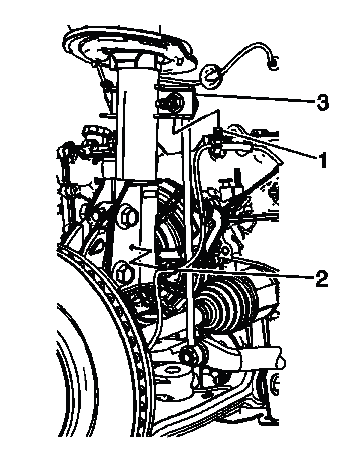
Fig. 39: Identifying Wheel Speed Sensor Wiring Harness & Front Strut
5. If removing the front strut to service any other suspension or steering component, scribe a line in the steering knuckle against the front strut. This will aid in the realigning the front suspension.
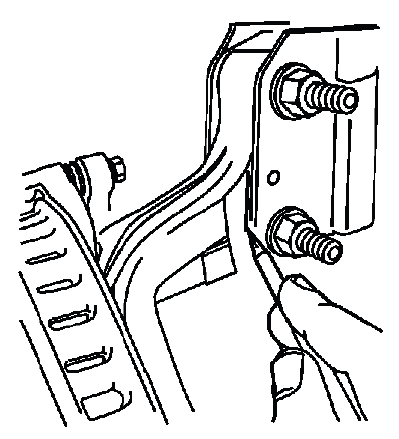
Fig. 40: Scribing Strut To Knuckle
6. Lower the vehicle to gain access to the upper strut mounting bolts.
7. Remove the front strut mounting bolts and nuts.
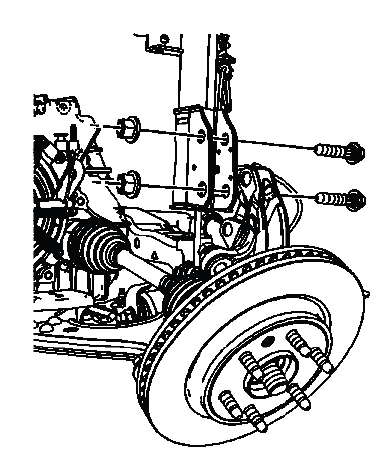
Fig. 41: Identifying Front Strut Mounting Bolts & Nuts
8. Remove the upper strut mounting nuts.
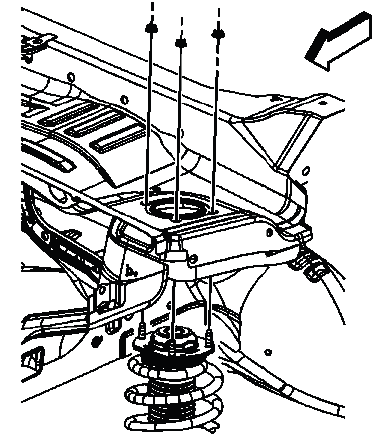
Fig. 42: Identifying Upper Strut Mounting Nuts
9. Separate the front strut from the steering knuckle.
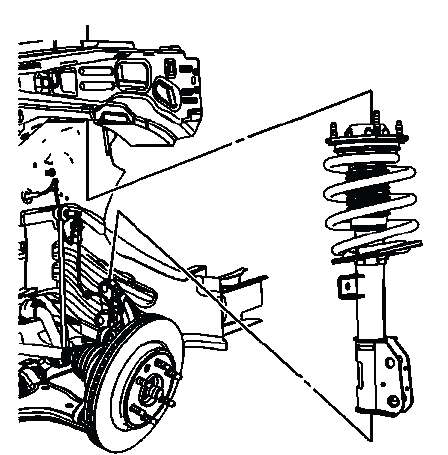
Fig. 43: Identifying Front Strut Assembly
NOTE: To reduce the brake hose stress during strut removal, install a jack stand under the steering knuckle.
10. Remove the front strut assembly from the vehicle.
11. If replacing the strut or the spring, refer to Strut, Strut Component or Spring Replacement.
Installation Procedure
1. Position the front strut in the strut tower.
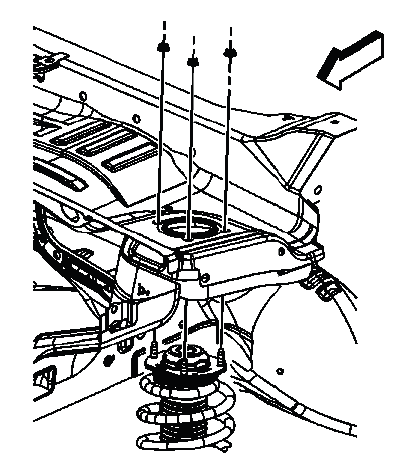
Fig. 44: Identifying Upper Strut Mounting Nuts
2. Install the upper strut mounting nuts.
CAUTION: Refer to Fastener Caution.
Tighten
- Tighten the mounting nut to 45 N.m (33 lb ft).
3. Raise the vehicle.
4. Position the front strut on the steering knuckle.
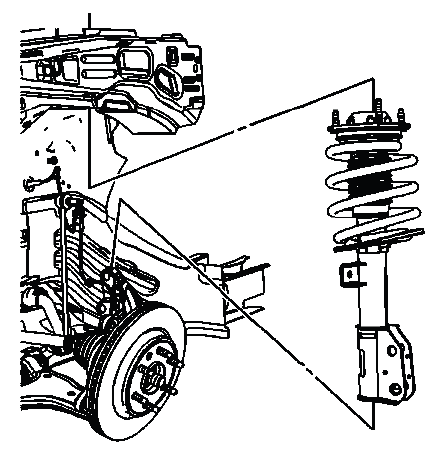
Fig. 45: Identifying Front Strut Assembly
NOTE: To reduce the brake hose stress during strut installation, install a jack stand under the steering knuckle.
NOTE: If installing the front strut after servicing another steering or suspension component, align the front strut to the scribe mark on the steering knuckle.
5. Install the front strut to steering knuckle mounting nuts and bolts.
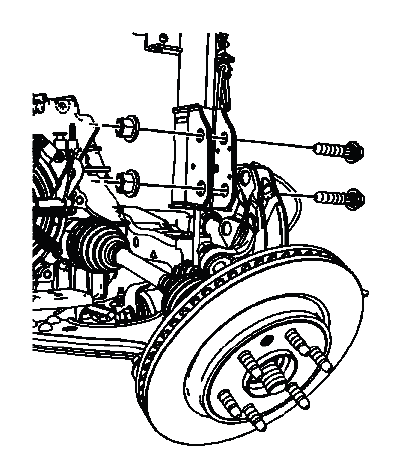
Fig. 46: Identifying Front Strut Mounting Bolts & Nuts
Tighten
- Tighten the mounting nut to 195 N.m (144 lb ft).
6. Install the stabilizer link at the front strut. Refer to Stabilizer Shaft Link Replacement.
7. Install the wheel speed sensor wiring harness (1) and (2) on the front strut (3).
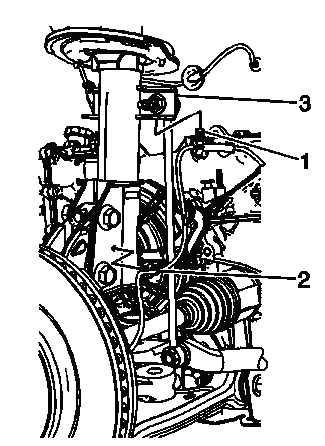
Fig. 47: Identifying Wheel Speed Sensor Wiring Harness & Front Strut
8. Install the air inlet grille. Refer to Air Inlet Grille Panel Replacement.
9. Align the front end. Refer to Wheel Alignment Measurement.
SUSPENSION SHOCK/STRUT DISPOSAL
WARNING: Use the proper eye protection when drilling to prevent metal chips from causing physical injury.
1. Clamp the strut in a vise horizontally with the rod (1) completely extended.
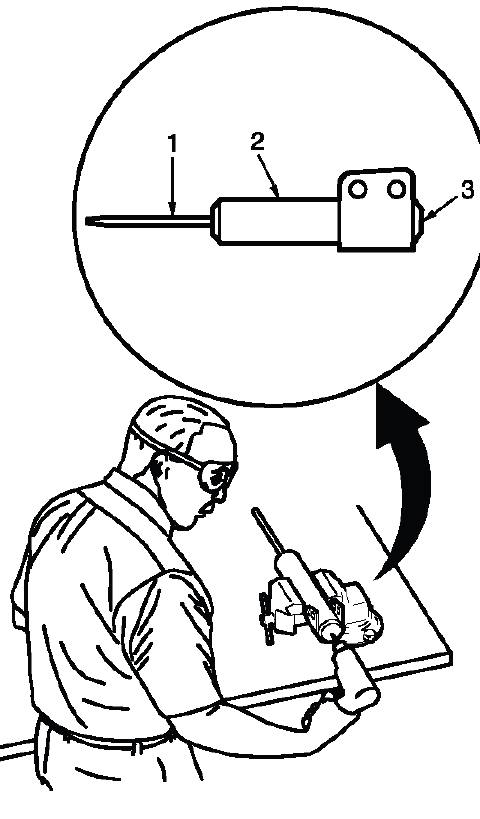
Fig. 48: Drilling Hole In Strut At Center Of End Cap
2. Drill a hole in the strut at the center of the end cap (3) using a 5 mm (3/16 in) drill bit. Gas or a gas/oil mixture will exhaust when the drill bit penetrates the strut. Use shop towels in order to contain the escaping oil.
3. Remove the strut from the vise.
4. Hold the strut over a drain pan vertically with the hole down.
5. Move the rod (1) in and out of the tube (2) to completely drain the oil from the strut.
STRUT, STRUT COMPONENT OR SPRING REPLACEMENT
Special Tools
- J 42991 Strut Rod Nut Socket
- J 45400 Strut Spring Compressor
Disassembly Procedure
1. Remove the strut from the vehicle. Refer to Strut Assembly Removal and Installation.
2. Install the strut (2) in the J 45400 Strut Spring Compressor (1).
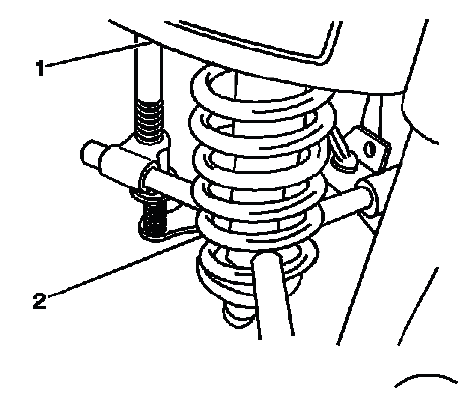
Fig. 49: Compressing/Releasing Lower Part Of Shock Spring
3. Turn the spring compressor forcing screw (1) until the coil spring (2) is compressed.
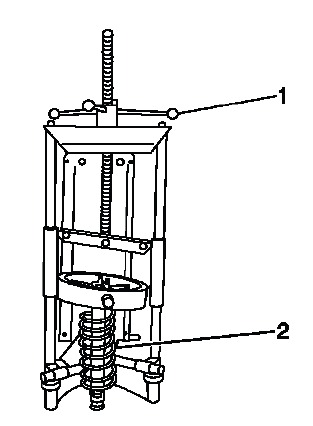
Fig. 50: View Of Compressor Forcing Screw & Coil Spring
NOTE: The spring is compressed when the strut moves freely.
4. Using a socket or a wrench hold the strut rod, use the J 42991 Strut Rod Nut Socket and a ratchet wrench, remove the strut rod nut.
5. Remove the strut from the J 45400 Strut Spring Compressor.
6. Loosen the compressor forcing screw (1) until the upper strut mount and coil spring (2) may be removed.
7. Remove the upper strut mount and the coil spring from the J 45400 Strut Spring Compressor.
Assembly Procedure
1. Prior to reassembling the strut components, apply a small amount of lubricant to the strut rod and the inside of the jounce bumper. Refer to Adhesives, Fluids, Lubricants and Sealers.
2. Install the coil spring and upper strut mount to the J 45400 Strut Spring Compressor.
3. Turn the spring compressor forcing screw (1) until the coil spring is compressed.
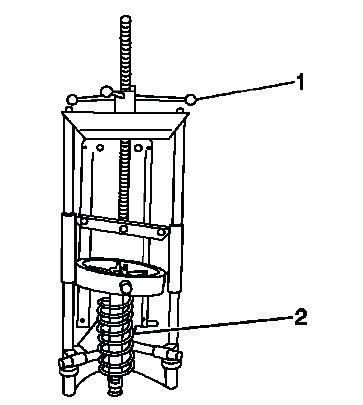
Fig. 51: View Of Compressor Forcing Screw & Coil Spring
4. Install the strut to the coil spring and upper strut mount.
5. Loosely install the strut retaining nut.
6. Using a socket or a wrench hold the strut rod.
7. With the wrench or socket holding the strut rod, use the J 42991 Strut Rod Nut Socket and a torque to install the upper strut mount nut. Tighten the strut mount nut to 85 N.m (63 lb ft).
CAUTION: Refer to Fastener Caution.
8. Remove the strut from the J 45400 Strut Spring Compressor.
9. Install the strut to the vehicle. Refer to Strut Assembly Removal and Installation.

